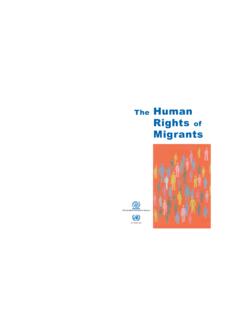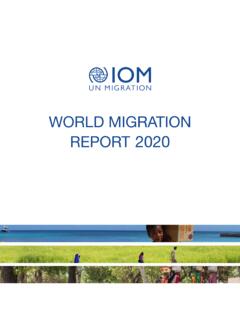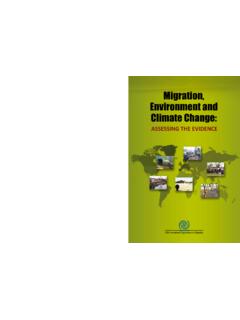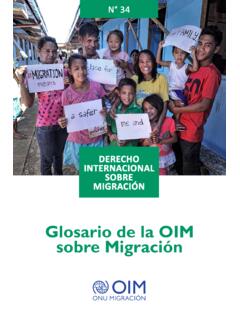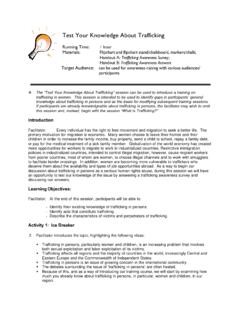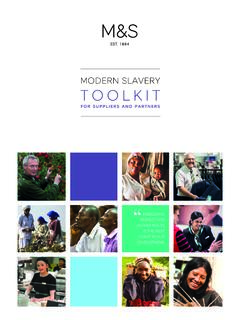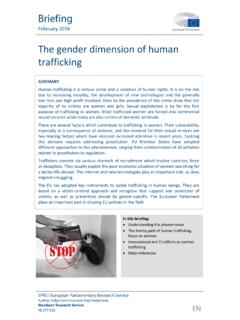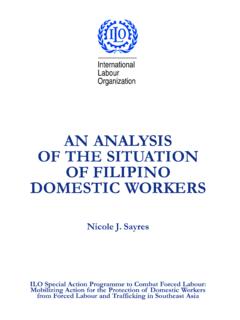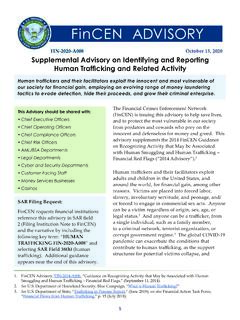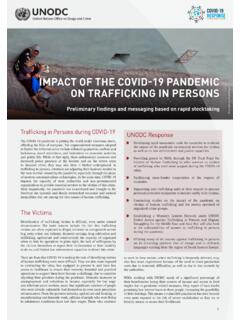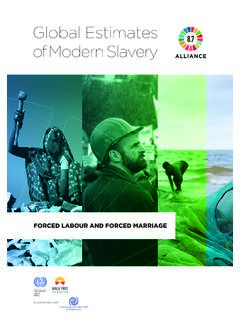Transcription of MIGRANTS AND THEIR VULNERABILITY
1 Publication authors: Fiona David, Katharine Bryant and Jacqueline Joudo LarsenMIGRANTS AND THEIR VULNERABILITYTO human trafficking , MODERN SLAVERY AND FORCED LABOURC ontributors:The authors would like to acknowledge the contributions of John Latham, Gareth Larsen and Asha McNeill, who conducted: the initial literature searches and prepared document reviews including an annotated bibliography, provided writing assistance and technical editing. The authors would also like to thank Andria Kenney and Mathieu Luciano from IOM who enabled expert discussions on a draft of the report and also provided input as the research opinions expressed in this report are those of the authors and do not necessarily reflect the views of the International Organization for Migration (IOM).
2 The designations employed and the presentation of material throughout the report do not imply the expression of any opinion whatsoever on the part of IOM concerning the legal status of any country, territory, city or area, or of its authorities, or concerning its frontiers or is committed to the principle that humane and orderly migration benefits MIGRANTS and society. As an intergovernmental organization, IOM acts with its partners in the international community to: assist in meeting the operational challenges of migration; advance understanding of migration issues; encourage social and economic development through migration; and uphold the human dignity and well-being of publication was made possible through the funding provided by UK aid from the UK government, under the terms of HQS/ DFID.
3 The views expressed herein do not necessarily reflect the views of the UK government or its official : International Organization for Migration17 route des Morillons1211 Geneva 19 SwitzerlandTel: + 91 11 Fax: + 61 50E-mail: report has been issued without formal editing by IOM. 2019 International Organization for Migration (IOM)All rights reserved. No part of this publication may be reproduced, stored in a retrieval system, or transmitted in any form or by any means, electronic, mechanical, photocopying, recording, or otherwise without the prior written permission of the cover image: Venezuelans load cars with goods and food on the irregular migration routes connecting Bolivarian Republic of Venezuela and Pacaraima, Brazil.
4 MIGRANTS who use irregular migration routes are vulnerable to exploitation due to high-risk situations including the profit motives of smuggling networks and the presence of organized crime. Credit: Victor Moriyama/Getty Images CONTENTSFAST FACT S ..4 EXECUTIVE SUMMARY ..8 Where are MIGRANTS most vulnerable? ..10 Which MIGRANTS are most vulnerable? ..10 What enables MIGRANTS to be abused and exploited? ..10 What about existing government protections for MIGRANTS ? ..11 Recommendations ..12 Recommendation 1: Increase protections for victims and vulnerable MIGRANTS .
5 12 Recommendation 2: Reduce capacity and opportunity for potential offenders ..13 Recommendation 3: Increase capacity and focus of guardians and first responders ..13 Recommendation 4: Focus research efforts on filling critical gaps in knowledge ..14 INTRODUCTION ..16 METHODOLOGY ..20 KEY FEATURES OF THE KNOWLEDGE BASE ..21 Methods of studies ..21 Thematic coverage ..21 Geographic focus ..22 Economic sector or purpose of exploitation ..24 Sites of VULNERABILITY ..25 SITES OF VULNERABILITY IN THE MIGRATION PROCESS.
6 26 Areas beyond the reach of state protection ..27 Private dwellings ..28 Private businesses ..28 Border crossings ..29 Irregular migration routes ..30 Displacement sites and refugee zones ..31 Natural disasters ..31 Ships ..31 Rural areas ..32 Commercial sex establishments ..32 ContentsContents MIGRANTS and THEIR VULNERABILITY to human trafficking , modern slavery and forced labour1 VICTIM CHARACTERISTICS ..34 Children and youth ..35 Gender ..37 Visa status ..38 Knowledge and attitude toward migration ..38 Secondary displacement.
7 39 Repeat exploitation ..39 Length of travel ..39 Sexual orientation and identity ..39 Language ability ..40 Drug or alcohol addiction ..40 Health ..40 Poverty ..41 Education ..42 Necessity to support dependents ..43 Abusive or unstable family background ..43 Homelessness or lack of family support ..43 Cultural norms ..43 Lack of a local support network ..44 Caste status ..44 Globalization and inequality ..44 Discrimination against MIGRANTS ..45 OFFENDER CHARACTERISTICS ..46 Typologies ..47 Offender motivations.
8 48 Perception ..49 Resources relevant to offending ..49 Contents2 MIGRANTS and THEIR VULNERABILITY to human trafficking , modern slavery and forced labour GUARDIAN CHARACTERISTICS ..54 Gaps in responses ..55 Gaps in legislation ..55 Gaps in social protections and labour rights ..56 Non-recognition of foreign qualifications ..57 Restrictive immigration policies and weak migration governance structures ..57 Barriers to collective bargaining ..58 State-imposed forced labour ..59 Lack of political will or capacity to respond.
9 60 Conflict and natural disasters ..60 Corruption ..60 Complexity of the crime types ..61 Stereotypes and gaps in understanding ..61 Discrimination and prejudice ..62 ANALYSIS AND RECOMMENDATIONS ..64 Which MIGRANTS are vulnerable, when and in what circumstances? ..64 Pre-migration ..65In transit ..65At destination ..66On return ..66 Addressing the intersections of risk ..67 Recommendation 1: Increase protections for victims and vulnerable MIGRANTS ..67 Recommendation 2: Reduce capacity and opportunity for potential offenders.
10 67 Recommendation 3: Increase capacity and focus of guardians and first responders ..68 Recommendation 4: Focus research efforts on filling critical gaps in knowledge ..68 ATTACHMENT A: RESEARCH PROTOCOL ..70 ATTACHMENT B: LIST OF COUNTRIES OR PLACES AND NUMBER OF STUDIES FOUND ..78 ATTACHMENT C: LIST OF COUNTRIES OR PLACES WITH NO STUDIES LOCATED ..94 Contents MIGRANTS and THEIR VULNERABILITY to human trafficking , modern slavery and forced labour3FA S T FAC T STHERE ARE 258 MILLION MIGRANTS .* WITHIN THIS, AN UNKNOWN NUMBER ARE ALSO PART OF THE ESTIMATED 40 MILLION PEOPLE LIVING IN MODERN SLAVERY.
